Dongyuan Li
A Call for Collaborative Intelligence: Why Human-Agent Systems Should Precede AI Autonomy
Jun 11, 2025Abstract:Recent improvements in large language models (LLMs) have led many researchers to focus on building fully autonomous AI agents. This position paper questions whether this approach is the right path forward, as these autonomous systems still have problems with reliability, transparency, and understanding the actual requirements of human. We suggest a different approach: LLM-based Human-Agent Systems (LLM-HAS), where AI works with humans rather than replacing them. By keeping human involved to provide guidance, answer questions, and maintain control, these systems can be more trustworthy and adaptable. Looking at examples from healthcare, finance, and software development, we show how human-AI teamwork can handle complex tasks better than AI working alone. We also discuss the challenges of building these collaborative systems and offer practical solutions. This paper argues that progress in AI should not be measured by how independent systems become, but by how well they can work with humans. The most promising future for AI is not in systems that take over human roles, but in those that enhance human capabilities through meaningful partnership.
Automating eHMI Action Design with LLMs for Automated Vehicle Communication
May 27, 2025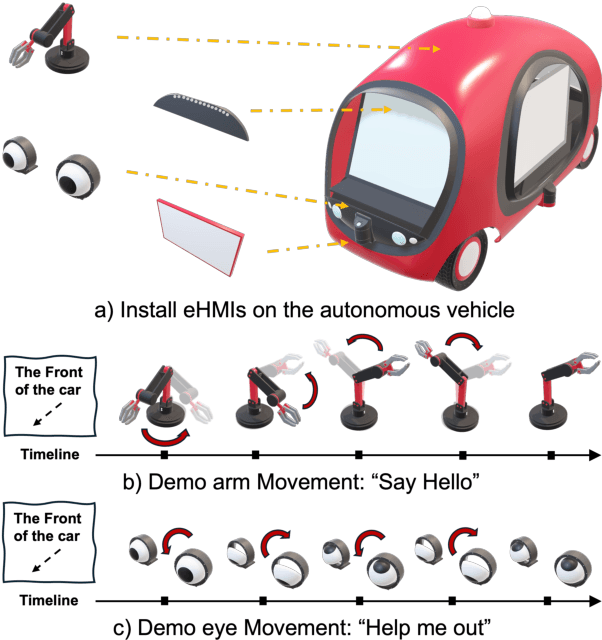
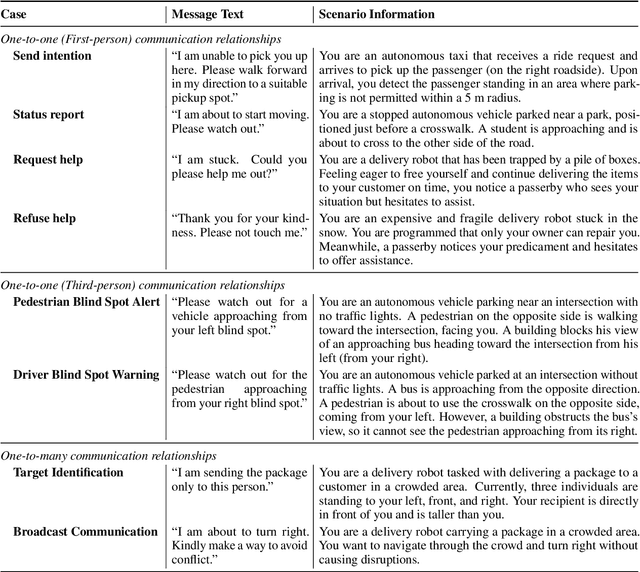
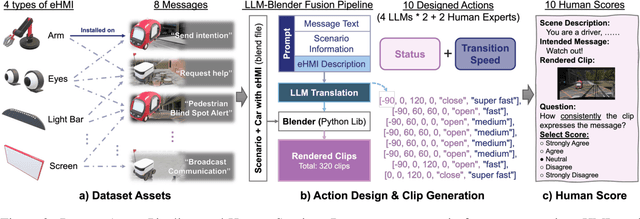

Abstract:The absence of explicit communication channels between automated vehicles (AVs) and other road users requires the use of external Human-Machine Interfaces (eHMIs) to convey messages effectively in uncertain scenarios. Currently, most eHMI studies employ predefined text messages and manually designed actions to perform these messages, which limits the real-world deployment of eHMIs, where adaptability in dynamic scenarios is essential. Given the generalizability and versatility of large language models (LLMs), they could potentially serve as automated action designers for the message-action design task. To validate this idea, we make three contributions: (1) We propose a pipeline that integrates LLMs and 3D renderers, using LLMs as action designers to generate executable actions for controlling eHMIs and rendering action clips. (2) We collect a user-rated Action-Design Scoring dataset comprising a total of 320 action sequences for eight intended messages and four representative eHMI modalities. The dataset validates that LLMs can translate intended messages into actions close to a human level, particularly for reasoning-enabled LLMs. (3) We introduce two automated raters, Action Reference Score (ARS) and Vision-Language Models (VLMs), to benchmark 18 LLMs, finding that the VLM aligns with human preferences yet varies across eHMI modalities.
Understanding Fact Recall in Language Models: Why Two-Stage Training Encourages Memorization but Mixed Training Teaches Knowledge
May 22, 2025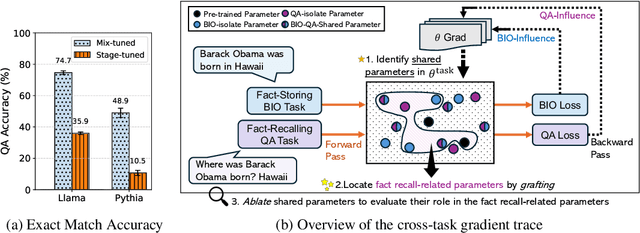

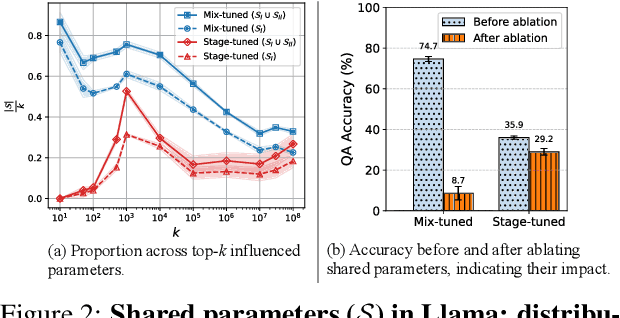
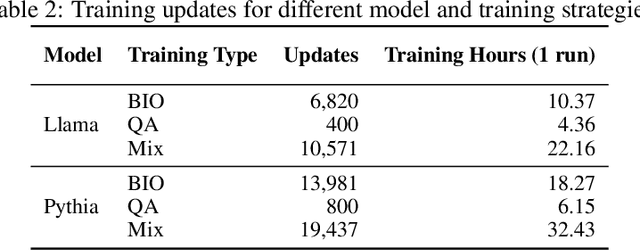
Abstract:Fact recall, the ability of language models (LMs) to retrieve specific factual knowledge, remains a challenging task despite their impressive general capabilities. Common training strategies often struggle to promote robust recall behavior with two-stage training, which first trains a model with fact-storing examples (e.g., factual statements) and then with fact-recalling examples (question-answer pairs), tending to encourage rote memorization rather than generalizable fact retrieval. In contrast, mixed training, which jointly uses both types of examples, has been empirically shown to improve the ability to recall facts, but the underlying mechanisms are still poorly understood. In this work, we investigate how these training strategies affect how model parameters are shaped during training and how these differences relate to their ability to recall facts. We introduce cross-task gradient trace to identify shared parameters, those strongly influenced by both fact-storing and fact-recalling examples. Our analysis on synthetic fact recall datasets with the Llama-3.2B and Pythia-2.8B models reveals that mixed training encouraging a larger and more centralized set of shared parameters. These findings suggest that the emergence of parameters may play a key role in enabling LMs to generalize factual knowledge across task formulations.
Taming Recommendation Bias with Causal Intervention on Evolving Personal Popularity
May 20, 2025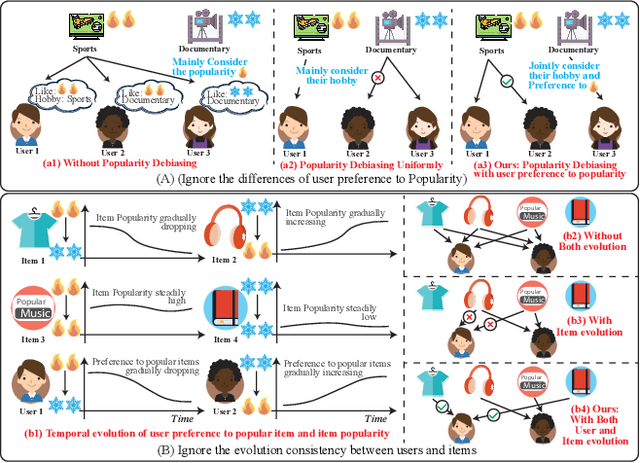
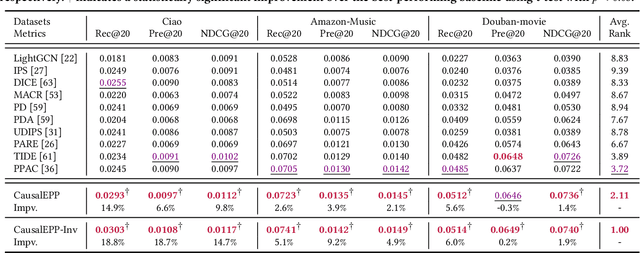

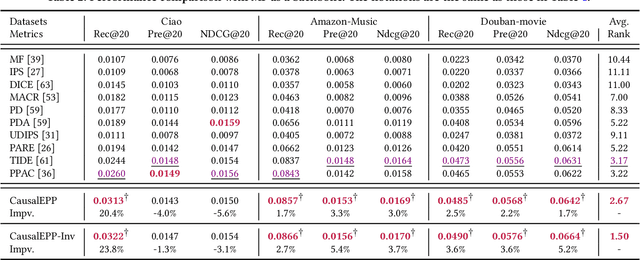
Abstract:Popularity bias occurs when popular items are recommended far more frequently than they should be, negatively impacting both user experience and recommendation accuracy. Existing debiasing methods mitigate popularity bias often uniformly across all users and only partially consider the time evolution of users or items. However, users have different levels of preference for item popularity, and this preference is evolving over time. To address these issues, we propose a novel method called CausalEPP (Causal Intervention on Evolving Personal Popularity) for taming recommendation bias, which accounts for the evolving personal popularity of users. Specifically, we first introduce a metric called {Evolving Personal Popularity} to quantify each user's preference for popular items. Then, we design a causal graph that integrates evolving personal popularity into the conformity effect, and apply deconfounded training to mitigate the popularity bias of the causal graph. During inference, we consider the evolution consistency between users and items to achieve a better recommendation. Empirical studies demonstrate that CausalEPP outperforms baseline methods in reducing popularity bias while improving recommendation accuracy.
A Survey on Large Language Model based Human-Agent Systems
May 01, 2025Abstract:Recent advances in large language models (LLMs) have sparked growing interest in building fully autonomous agents. However, fully autonomous LLM-based agents still face significant challenges, including limited reliability due to hallucinations, difficulty in handling complex tasks, and substantial safety and ethical risks, all of which limit their feasibility and trustworthiness in real-world applications. To overcome these limitations, LLM-based human-agent systems (LLM-HAS) incorporate human-provided information, feedback, or control into the agent system to enhance system performance, reliability and safety. This paper provides the first comprehensive and structured survey of LLM-HAS. It clarifies fundamental concepts, systematically presents core components shaping these systems, including environment & profiling, human feedback, interaction types, orchestration and communication, explores emerging applications, and discusses unique challenges and opportunities. By consolidating current knowledge and offering a structured overview, we aim to foster further research and innovation in this rapidly evolving interdisciplinary field. Paper lists and resources are available at https://github.com/HenryPengZou/Awesome-LLM-Based-Human-Agent-System-Papers.
A Unified Retrieval Framework with Document Ranking and EDU Filtering for Multi-document Summarization
Apr 23, 2025Abstract:In the field of multi-document summarization (MDS), transformer-based models have demonstrated remarkable success, yet they suffer an input length limitation. Current methods apply truncation after the retrieval process to fit the context length; however, they heavily depend on manually well-crafted queries, which are impractical to create for each document set for MDS. Additionally, these methods retrieve information at a coarse granularity, leading to the inclusion of irrelevant content. To address these issues, we propose a novel retrieval-based framework that integrates query selection and document ranking and shortening into a unified process. Our approach identifies the most salient elementary discourse units (EDUs) from input documents and utilizes them as latent queries. These queries guide the document ranking by calculating relevance scores. Instead of traditional truncation, our approach filters out irrelevant EDUs to fit the context length, ensuring that only critical information is preserved for summarization. We evaluate our framework on multiple MDS datasets, demonstrating consistent improvements in ROUGE metrics while confirming its scalability and flexibility across diverse model architectures. Additionally, we validate its effectiveness through an in-depth analysis, emphasizing its ability to dynamically select appropriate queries and accurately rank documents based on their relevance scores. These results demonstrate that our framework effectively addresses context-length constraints, establishing it as a robust and reliable solution for MDS.
Towards Explainable Doctor Recommendation with Large Language Models
Mar 04, 2025Abstract:The advent of internet medicine provides patients with unprecedented convenience in searching and communicating with doctors relevant to their diseases and desired treatments online. However, the current doctor recommendation systems fail to fully ensure the professionalism and interpretability of the recommended results. In this work, we formulate doctor recommendation as a ranking task and develop a large language model (LLM)-based pointwise ranking framework. Our framework ranks doctors according to their relevance regarding specific diseases-treatment pairs in a zero-shot setting. The advantage of our framework lies in its ability to generate precise and explainable doctor ranking results. Additionally, we construct DrRank, a new expertise-driven doctor ranking dataset comprising over 38 disease-treatment pairs. Experiment results on the DrRank dataset demonstrate that our framework significantly outperforms the strongest cross-encoder baseline, achieving a notable gain of +5.45 in the NDCG@10 score while maintaining affordable latency consumption. Furthermore, we comprehensively present the fairness analysis results of our framework from three perspectives of different diseases, patient gender, and geographical regions. Meanwhile, the interpretability of our framework is rigorously verified by three human experts, providing further evidence of the reliability of our proposed framework for doctor recommendation.
LAG: LLM agents for Leaderboard Auto Generation on Demanding
Feb 25, 2025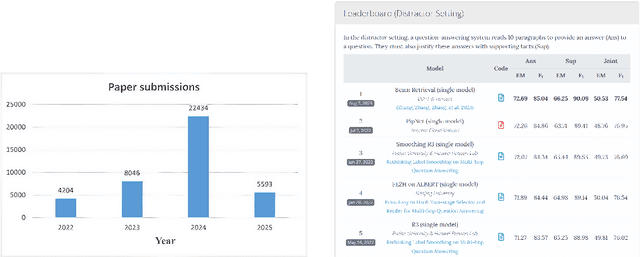

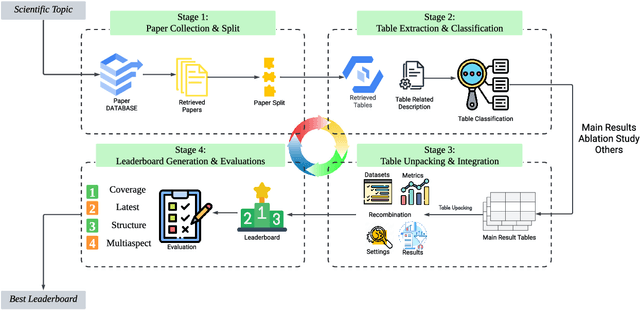

Abstract:This paper introduces Leaderboard Auto Generation (LAG), a novel and well-organized framework for automatic generation of leaderboards on a given research topic in rapidly evolving fields like Artificial Intelligence (AI). Faced with a large number of AI papers updated daily, it becomes difficult for researchers to track every paper's proposed methods, experimental results, and settings, prompting the need for efficient automatic leaderboard construction. While large language models (LLMs) offer promise in automating this process, challenges such as multi-document summarization, leaderboard generation, and experiment fair comparison still remain under exploration. LAG solves these challenges through a systematic approach that involves the paper collection, experiment results extraction and integration, leaderboard generation, and quality evaluation. Our contributions include a comprehensive solution to the leaderboard construction problem, a reliable evaluation method, and experimental results showing the high quality of leaderboards.
Multi-Agent Autonomous Driving Systems with Large Language Models: A Survey of Recent Advances
Feb 24, 2025Abstract:Autonomous Driving Systems (ADSs) are revolutionizing transportation by reducing human intervention, improving operational efficiency, and enhancing safety. Large Language Models (LLMs), known for their exceptional planning and reasoning capabilities, have been integrated into ADSs to assist with driving decision-making. However, LLM-based single-agent ADSs face three major challenges: limited perception, insufficient collaboration, and high computational demands. To address these issues, recent advancements in LLM-based multi-agent ADSs have focused on improving inter-agent communication and cooperation. This paper provides a frontier survey of LLM-based multi-agent ADSs. We begin with a background introduction to related concepts, followed by a categorization of existing LLM-based approaches based on different agent interaction modes. We then discuss agent-human interactions in scenarios where LLM-based agents engage with humans. Finally, we summarize key applications, datasets, and challenges in this field to support future research (https://anonymous.4open.science/r/LLM-based_Multi-agent_ADS-3A5C/README.md).
Revisiting Dynamic Graph Clustering via Matrix Factorization
Feb 10, 2025



Abstract:Dynamic graph clustering aims to detect and track time-varying clusters in dynamic graphs, revealing the evolutionary mechanisms of complex real-world dynamic systems. Matrix factorization-based methods are promising approaches for this task; however, these methods often struggle with scalability and can be time-consuming when applied to large-scale dynamic graphs. Moreover, they tend to lack robustness and are vulnerable to real-world noisy data. To address these issues, we make three key contributions. First, to improve scalability, we propose temporal separated matrix factorization, where a single matrix is divided into multiple smaller matrices for independent factorization, resulting in faster computation. Second, to improve robustness, we introduce bi-clustering regularization, which jointly optimizes graph embedding and clustering, thereby filtering out noisy features from the graph embeddings. Third, to further enhance effectiveness and efficiency, we propose selective embedding updating, where we update only the embeddings of dynamic nodes while the embeddings of static nodes are fixed among different timestamps. Experimental results on six synthetic and five real-world benchmarks demonstrate the scalability, robustness and effectiveness of our proposed method. Source code is available at https://github.com/Clearloveyuan/DyG-MF.
 Add to Chrome
Add to Chrome Add to Firefox
Add to Firefox Add to Edge
Add to Edge